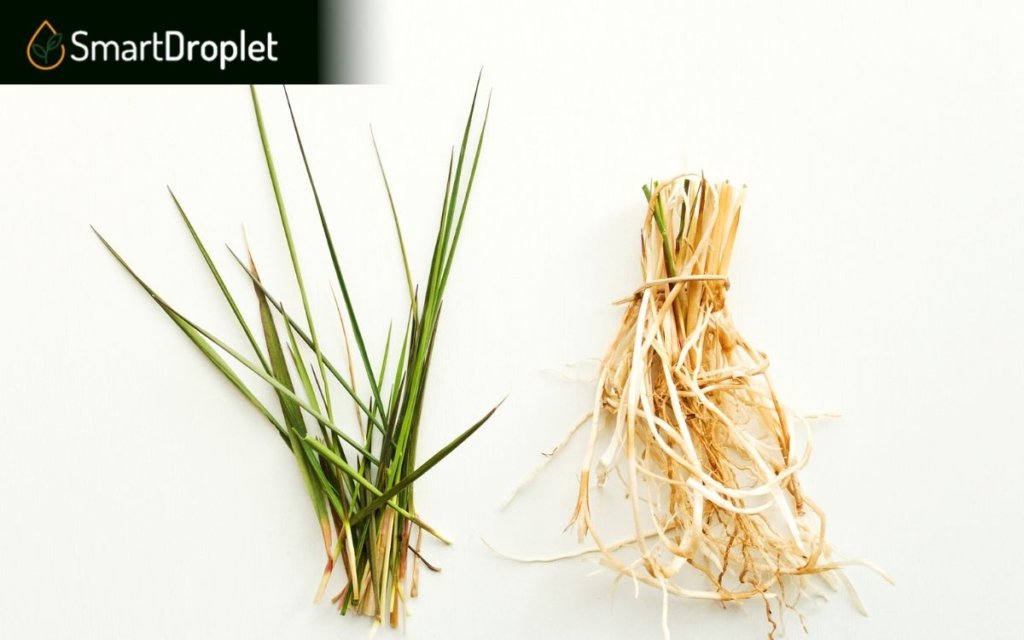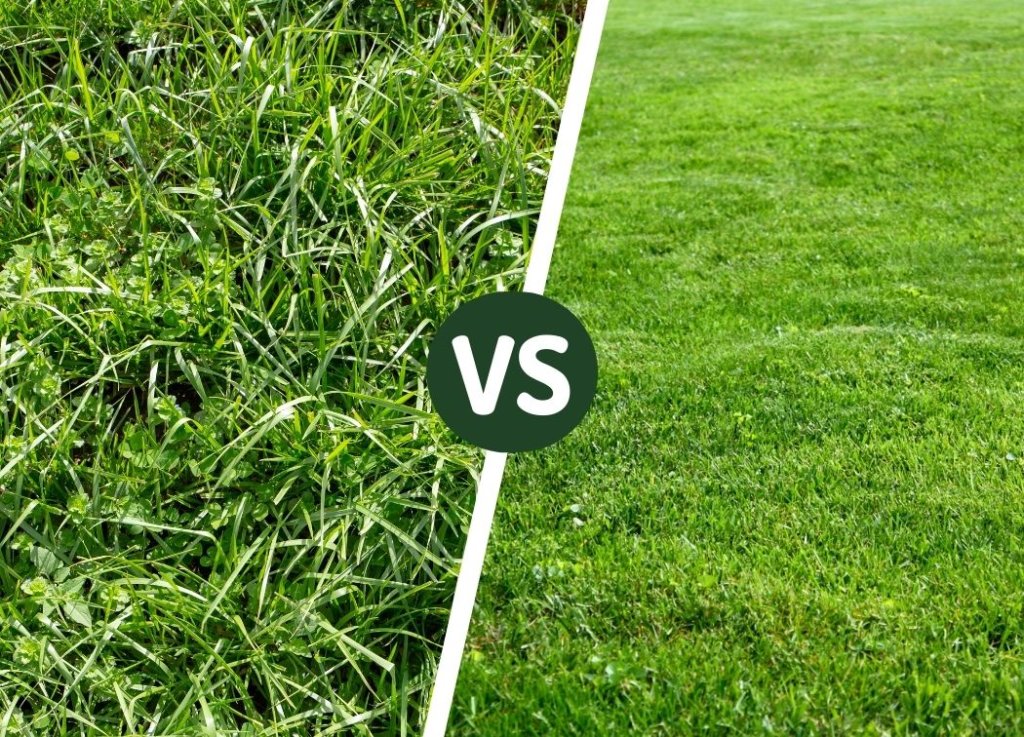Wide varieties of grass are used for lawns around the United States, but one of the most versatile and beloved types is Kentucky bluegrass.
Kentucky bluegrass or Poa pratensis is an aggressive and self-spreading grass with a medium to fine texture that can tolerate the cold of northern climates. Also called “Meadow grass,” this perennial species of grass can tolerate colder soil temperatures along with moderately warm summers. It’s best planted on northern lawns, but can survive within the transition zone when properly irrigated. This cool-season lawn staple has an attractive blue-green color and is best planted in the early fall. Its fine texture makes it soft to walk on and ideal for households that require more active lawns.
This guide will cover what you’ll need to know about this famed pasture grass and how it stacks up to other cool-season grasses. Read on!
What Does Kentucky Bluegrass Look Like?
Most varieties of Kentucky bluegrass have a pleasant dark green color and tend to grow thick across the lawn.
If you’re unsure whether you have Kentucky bluegrass growing on your lawn, pay attention to the form of the grass blade. This plant has a distinct boat-shaped leaf tip.
Kentucky bluegrass is native to Asia and Morocco despite its name. It sees extensive use in northern states because it prefers cold winters and moderately warm summers.
Some ranchers in the northern states plant Kentucky bluegrass as a pasture grass because it handles grazing well and bounces back during the spring.
This bluegrass is also prevalent along the West coast despite its intense water needs.
This plant also has shallow roots and spreads through rhizomes. You can dig up patches of your lawn to check the soil and whether it has shallow or deep roots.

How Do You Identify Kentucky Bluegrass From Other Cool Season Grasses?
Lawn owners who long for dense and thick turf need to know how to identify Kentucky bluegrass compared to other cool-season grasses. Follow these tips on what to look for:
- There are various species of Kentucky bluegrass, but take care not to confuse it with Annual bluegrass (Poa annua), which are grassy weeds.
- Annual bluegrass tends to be a lighter green than Kentucky bluegrass.
- Kentucky bluegrass has finer grass blades than Tall fescue, which tends to have coarser blades. Bluegrass seed also grows free and can be found in areas where it wasn’t planted.
- Tall fescue can tolerate compacted soils better than Kentucky bluegrass and spreads via stolons instead of rhizomes.
Species Data
- Tip of Leaf Blade: Boat-shaped leaf tip
- Leaf Blade Width: 2-4mm wide
- Seedhead/Flower: An opened panicle with flat spikelets
- Propagation Method: Via sod, plugs, or seed. It spreads through rhizomes and lacks stolons.
- Vernation Type: A bud with folded leaves within
- Ligule Type: Short and membranous, 0.2-1 mm in length
- Growing Season: Cool-season
- Auricle: No auricle present
What Are the Different Types of Kentucky Bluegrass?
Here are a few types designed for different purposes.
- Cheri -Cheri bluegrass has wider leaf blades and produces a stronger turf. It also grows lower to the ground.
- Compact Midnight -Compact Midnight bluegrass has a later spring green-up than other varieties, but it can tolerate higher soil temperatures.
Things to Note When Using it
Kentucky bluegrass prefers to grow out in the open but has mild shade tolerance.
Ensure that any shade around your yard is light and not dappled, resulting in patchy and uneven growth.
Kentucky bluegrass is commonly used for sports fields, golf courses, or other areas with lots of foot traffic.
It grows best when planted in early spring and thrives in Hardiness Zones 3 to 9. Its growth patterns make it perfect for reducing weeds, and its rhizomes are good for erosion control.
It cannot handle drought stress like Tall fescue can, so ensure that you give your lawn plenty of water during the summer months!
PROS:
- Excellent for high-traffic areas
- Its soft texture makes it ideal for running barefoot and for free
- Exceptional self-repair ability
CONS:
- It tends to go dormant quickly during the fall
- Requires plenty of watering during summer
- Grows slowly, especially when overexposed to heat
How Do You Properly Seed and Plant it?
Planting Kentucky bluegrass may seem easy, but establishing it is a high-maintenance ordeal. Follow these tips for dense and weed-free grass:
- Prepare your lawn for seeding around late summer. This will ensure that your yard is ready for seeding by fall, which is Kentucky bluegrass’ growing season. If you miss the fall, you can still plant it during early spring to fully use the spring green-up period. Keep an eye on your lawn during the winter, as it is susceptible to snow mold. Bag any loose clippings after mowing to protect your turf.
- Before planting any Kentucky bluegrass seed, aerate your soil and break up any compacted areas to help your lawn grow. Ensure you seed your lawn when soil temperatures are 50-65 degrees F. This warmth will help it thrive throughout winter.
How to Do Proper Maintenance
Plantation is only the first step.
Follow these maintenance tips to grow a healthy and lush bluegrass lawn:
Fertilization
Homeowners who want a dense turf need to mind their lawn’s fertilizer needs. Kentucky bluegrass requires soil pH levels of 6 to 7 for optimal growth. Prioritize slow-release fertilizers for newly-established lawns. This will ensure your yard gets enough nutrients but won’t be damaged by the fertilizer.
Lawn Mowing
Kentucky bluegrass can grow to 2 feet if left untended, but its recommended mowing height is 2.5-3.5 inches. Ensure that you only remove 1/3rd of the grass blade per run. During fall and spring, homeowners may need to mow their lawns once per week or more.
Watering
Kentucky bluegrass requires plenty of water. Provide your lawn with 1.5-2.5 inches of water a week to keep it nice and green. This may require adjustment if you live in the transition zone. Kentucky Bluegrass lawns may not be as popular in West Coast states like California due to their watering needs, but they can be grown with proper irrigation.
Pest Control
Extreme heat can leave your Kentucky bluegrass infested with chinch bugs, which will cause your lawn to look drought-stressed. Apply a pesticide during summer to rid your lawn of these pests, and follow the pesticide instructions carefully.
Weed Control
Kentucky bluegrass will thin under the summer heat and create a favorable environment for weeds to sprout. Water your yard properly to keep it from developing any damaged spots. Your lawn may be prone to outbreaks of Annual bluegrass, which can be solved by applying a pre-emergent herbicide before fall.
Aeration/Dethatching
Kentucky bluegrass lawns will grow horizontally, developing a nice thick turf when given the proper care. This environment will choke out weeds and keep your lawn green and healthy. However, pests and other diseases can still damage your lawn. These pests thrive in excessively moist and compacted soil. Ensure that you aerate your lawn at least once a year to prevent thatch from developing. Once your lawn has developed thatch that’s over 1/2 an inch thick, it’s time to aerate.
Overwintering
One reason lawn owners plant Kentucky bluegrass on their lawns is its excellent winter hardiness. This non-native seed is well-suited to cold winters and will bounce back quickly during the spring green-up. Remove any debris you spot around the yard during this season.
What Are the Common Issues When Planting Kentucky Bluegrass?
While Kentucky bluegrass’ penchant for growing free is a big plus, it does have one issue: Heavy water usage
Ensure your lawn has enough water to keep it healthy during summer. Like other varieties of cool-season grass, Kentucky bluegrass has a low tolerance for heat and drought.
Give your lawn at least 2.5 inches of water per week, and water early in the morning to give your turf enough time to soak up the water.
Frequently Asked Questions (FAQs)
Learn more about having a Kentucky bluegrass lawn here!
Is Kentucky Bluegrass a Good Lawn Grass?
Kentucky bluegrass was originally used as a pasture grass in the United States because it can easily bounce back despite frequent grazing. However, it’s also an ideal lawn grass.
It will last indefinitely if tended to properly, thanks to its underground stems. The stems of a Kentucky bluegrass lawn will continue to grow and self-repair.
This aggressive growing cycle has earned it a reputation akin to weeds in other countries, but it is ideal for lawns in the United States.
Does Kentucky Bluegrass Like Sun or Shade?
A Kentucky bluegrass lawn will grow best in the full sun despite being cool-season grass.
Note that this doesn’t mean you can let your lawn bake in the Summer months.
An extended drought combined with high heat will cause other cool-season grasses to wilt, and Kentucky bluegrass is no exception.
This fairly high-maintenance grass will need lots of water during the summer months.
This grass type has limited shade tolerance, but some mixed seed varieties will have a greater shade tolerance. Check your seed bag’s label for a more accurate idea.
Is Kentucky Bluegrass Hard to Grow?
One point in this grass type’s favor is its ease of growth.
Kentucky bluegrass will form a lush grass carpet when given enough water and space to spread.
Water your newly-seeded lawn with 2 inches of water per week until it’s grown roughly 2 to 3 inches tall.
Once it’s reached this point, it’s time to trim the lawn.
If you want a lower-maintenance lawn, Kentucky bluegrass is not for you. It’s more finicky than other cool-season grasses and has more specific needs, but it’s tough and spreads well.
Does Kentucky Bluegrass Come Back Every Year?
Kentucky bluegrass is a tough variety of grass; any lawns planted with it will be stuck with it for years to come.
As a perennial grass variety, it will return continuously after a single planting.
Like other cool-season grasses like Perennial ryegrass, Kentucky bluegrass lawns will do well in the winter but tend to suffer during the warmer summer months.
Despite this grass’ mild drought tolerance, it will still fall dormant if left without water for enough time. Expect your grass to turn brown and dormant during extended droughts.
Conclusion
Despite calling itself the “Bluegrass State,” Kentucky bluegrass isn’t native to Kentucky but hails from Europe. However, this cool-season grass is perfectly suited to growing in the South.
Kentucky bluegrass is the perfect choice for homeowners with active households, thanks to its high tolerance to foot traffic.
A good blend of Kentucky bluegrass will form a lush carpet that’s easy on the feet and well-suited to the northern part of the United States.

